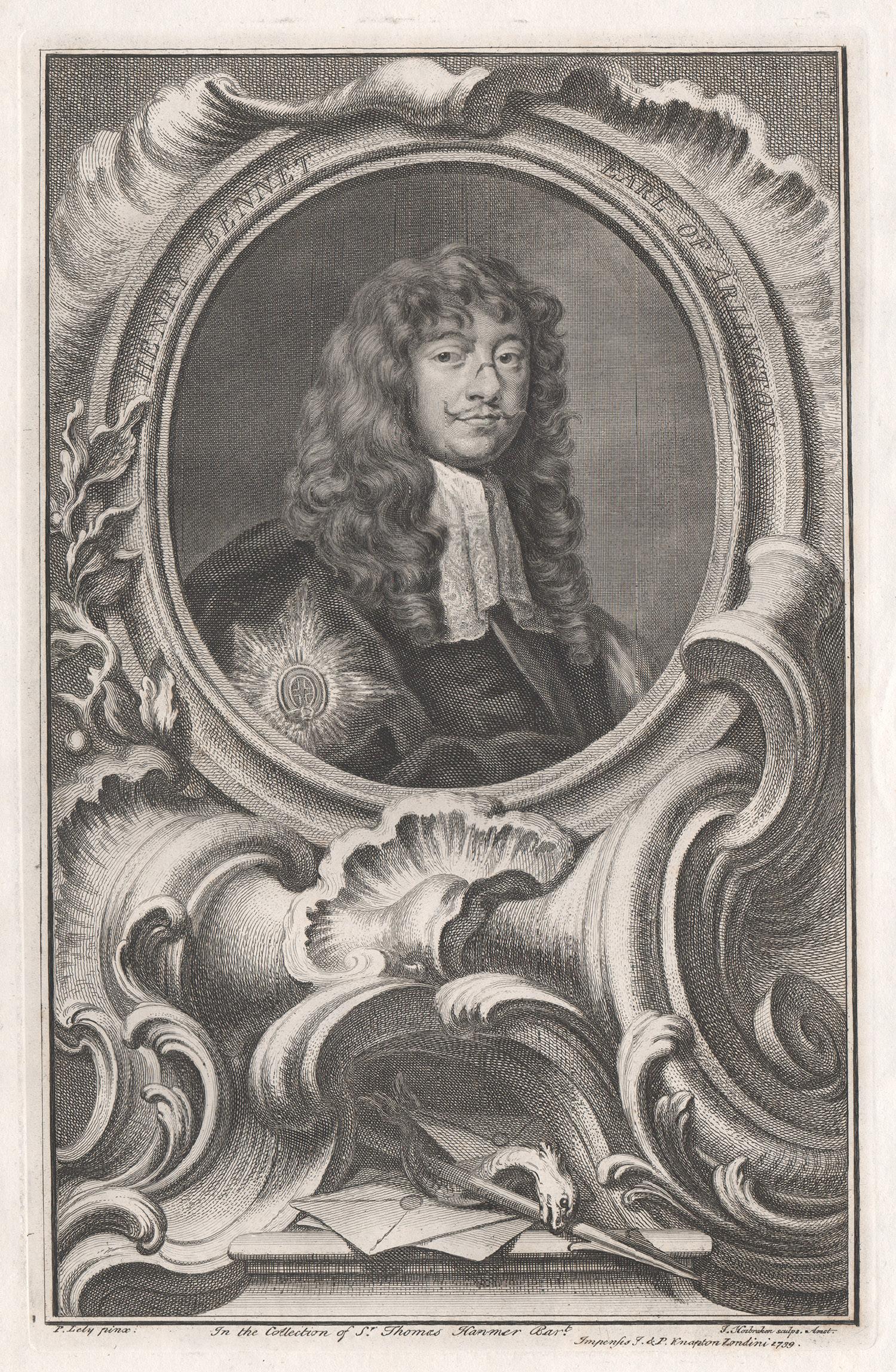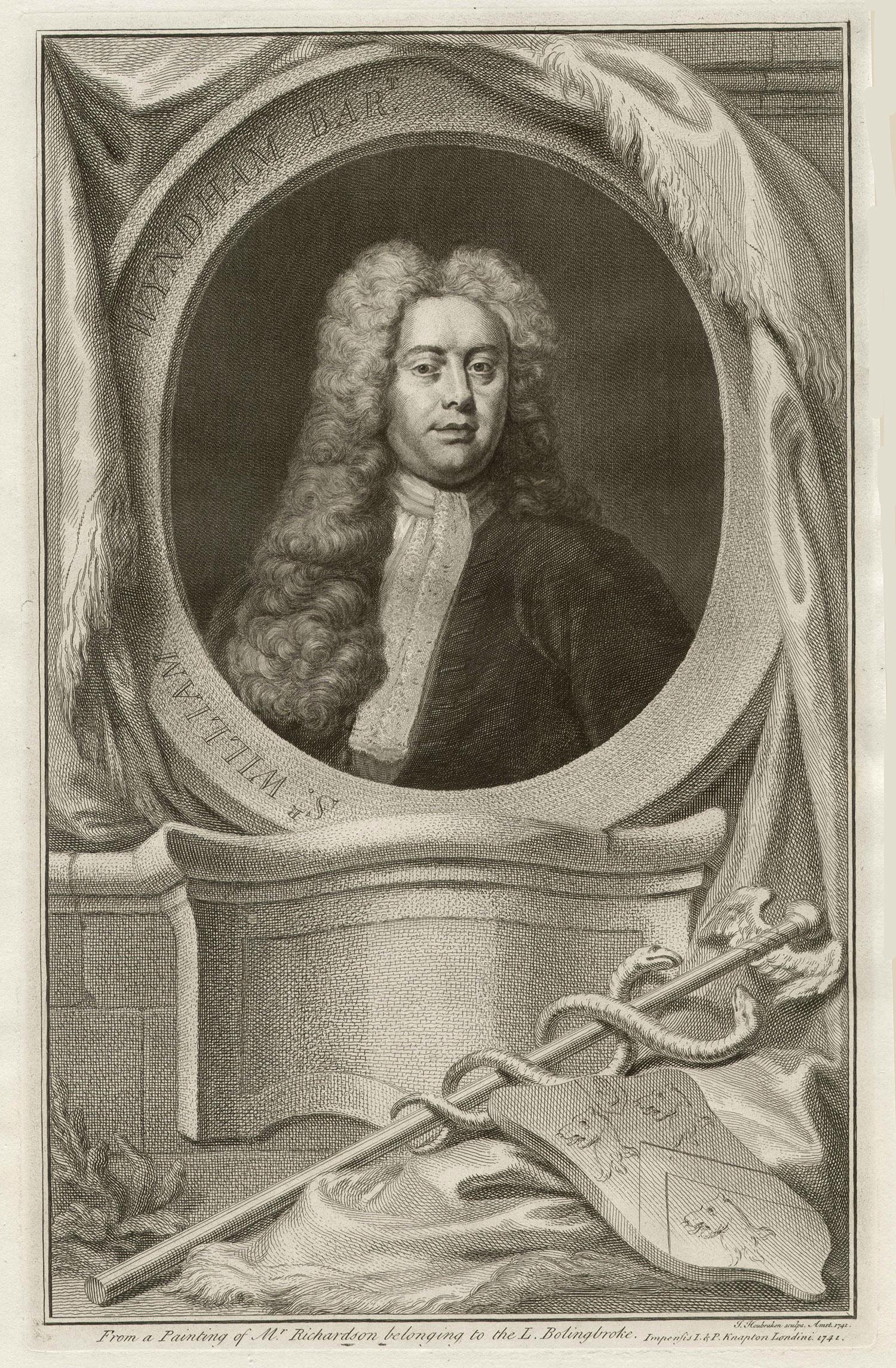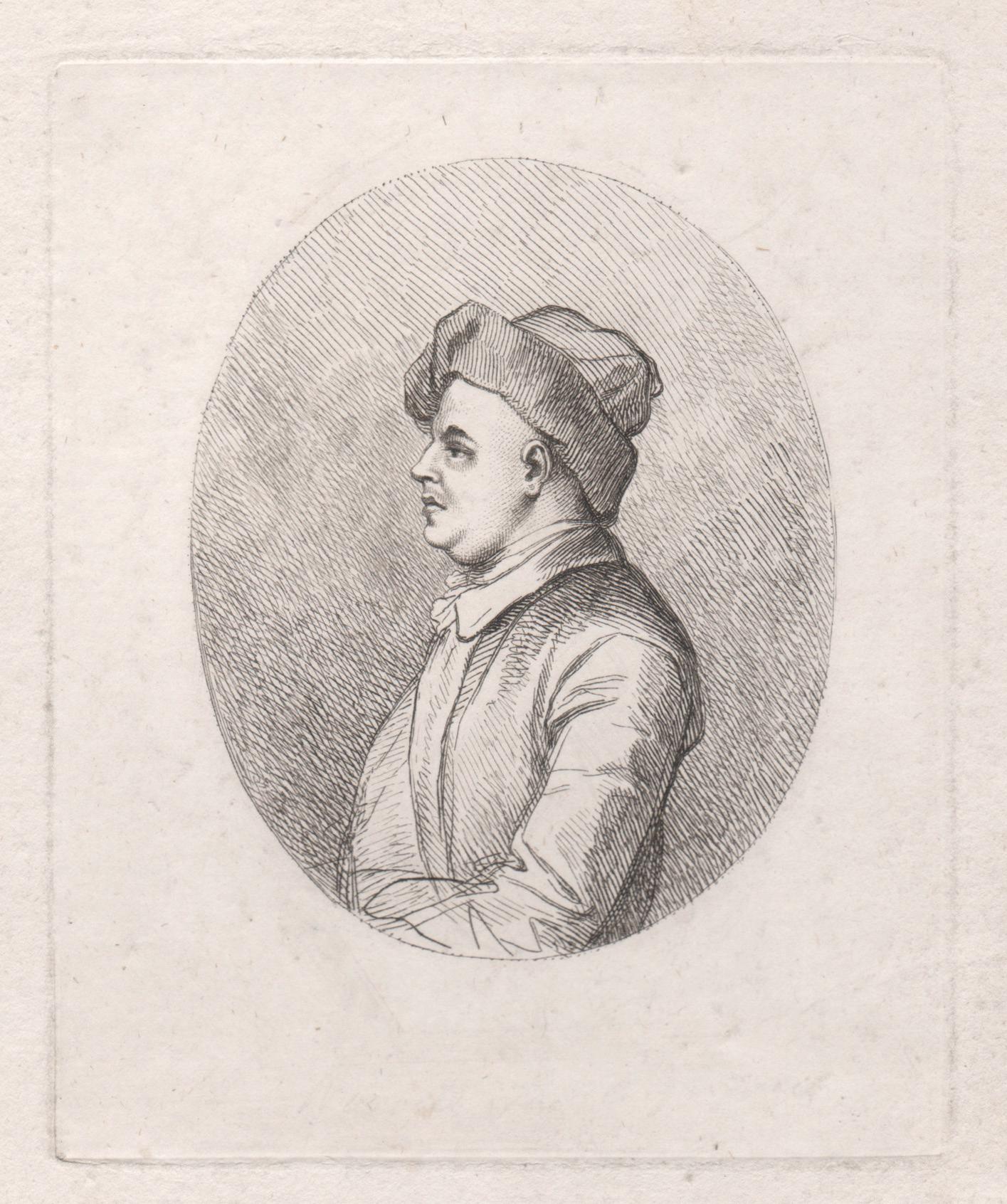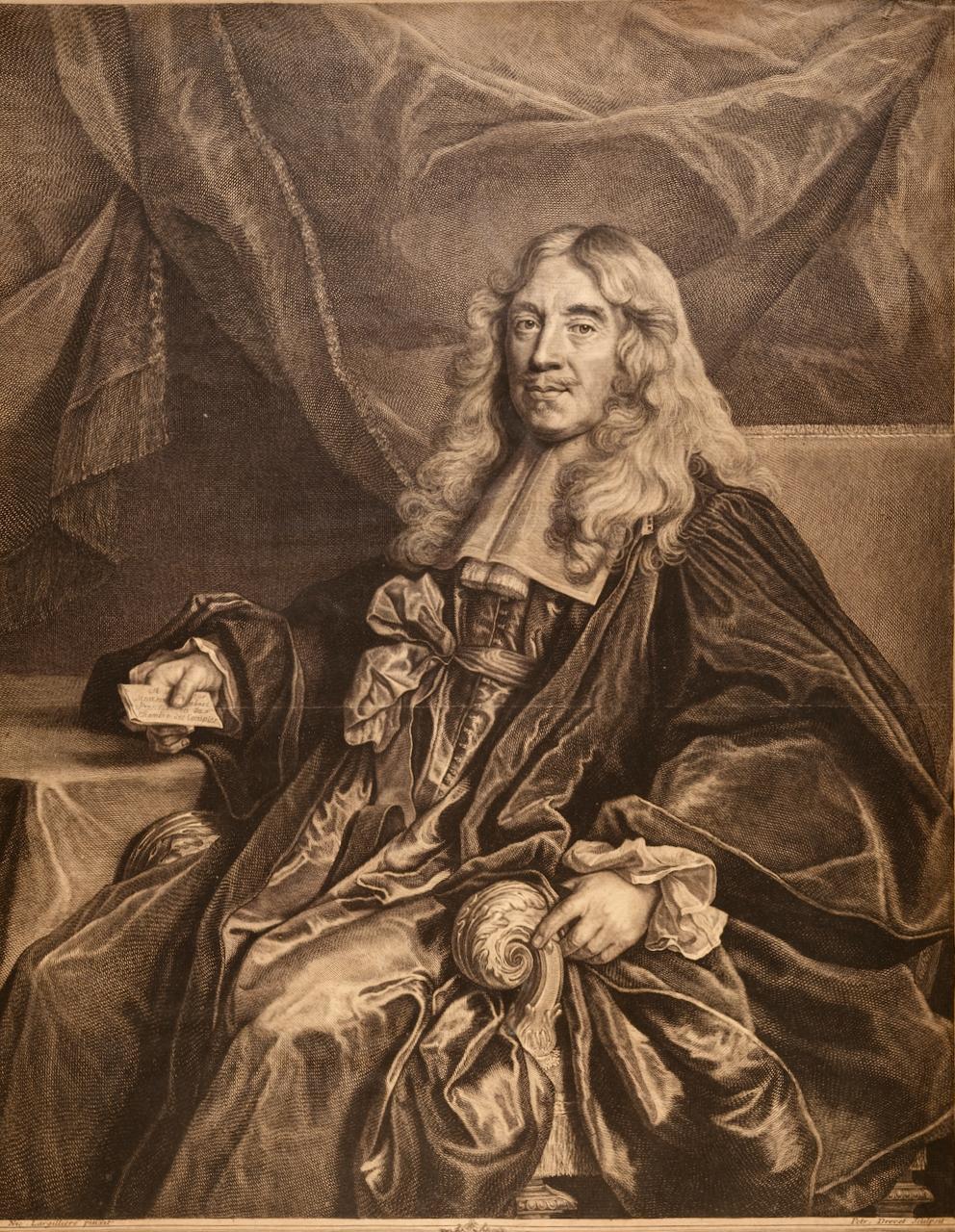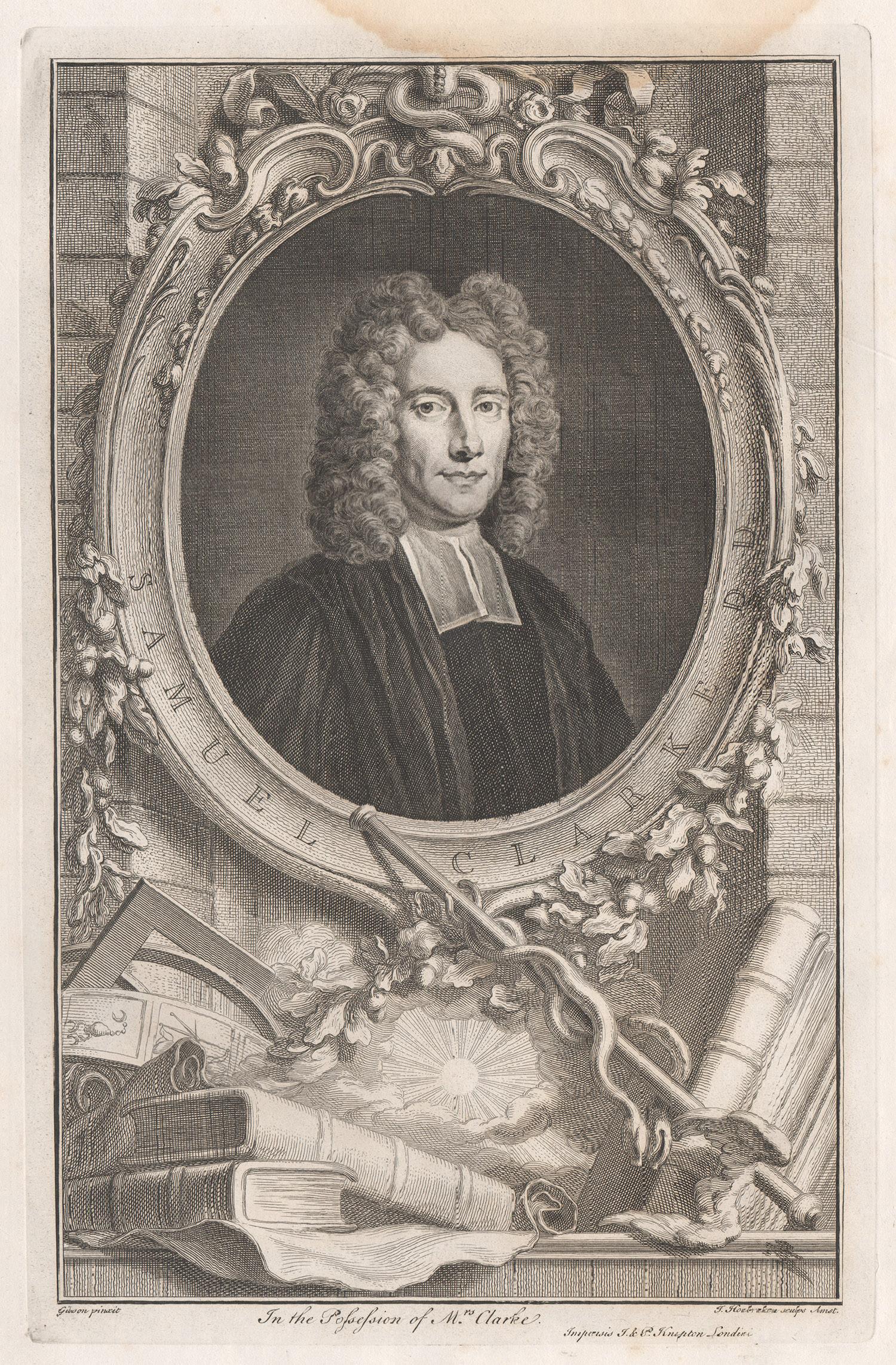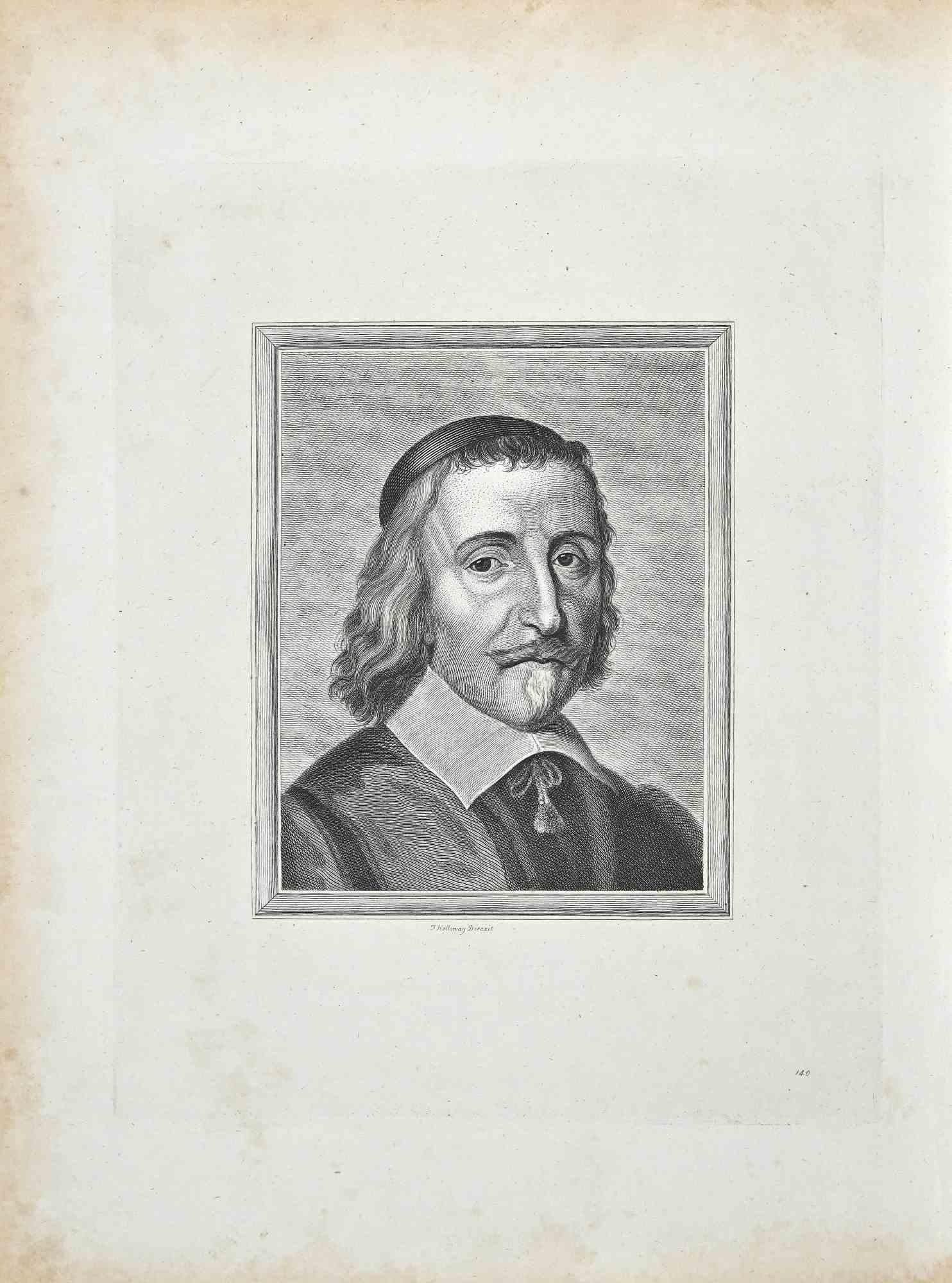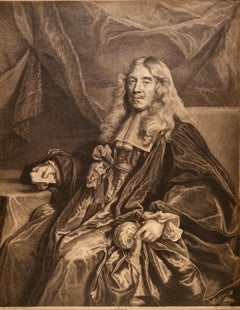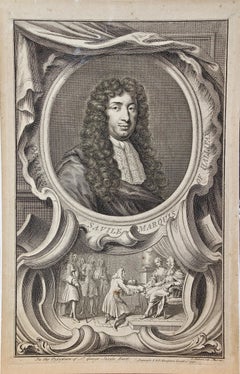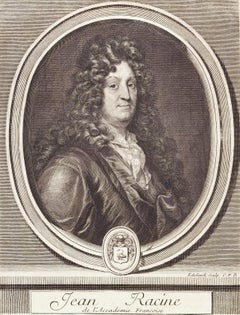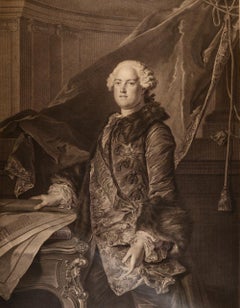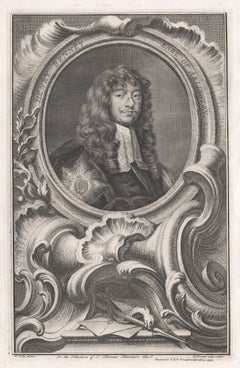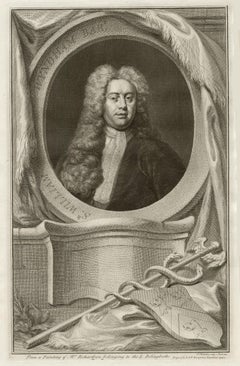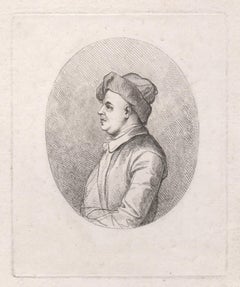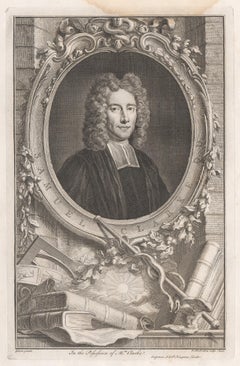Items Similar to Sir. John Powell, Knight: Early 18th C. Engraved Portrait After William Sherwin
Want more images or videos?
Request additional images or videos from the seller
1 of 8
Sir. John Powell, Knight: Early 18th C. Engraved Portrait After William Sherwin1711
1711
$620
$77520% Off
£481.27
£601.5920% Off
€545.91
€682.3920% Off
CA$885.26
CA$1,106.5820% Off
A$975.49
A$1,219.3620% Off
CHF 505.97
CHF 632.4620% Off
MX$11,602.10
MX$14,502.6220% Off
NOK 6,400.36
NOK 8,000.4520% Off
SEK 5,995.78
SEK 7,494.7220% Off
DKK 4,077.13
DKK 5,096.4120% Off
About the Item
This is an early 18th century portrait of Sir John Powell entitled "The Honorable Sr. John Powell, Knight. one of the Justices of her Majesties' Court of Common Pleas. Ano. D 1711". It was engraved and published by John King in London in 1711, after an earlier work by William Sherwin. The engraving depicts a bust length portrait of Powell wearing an elaborate fir-trimmed robe and collar. The portrait is encompassed in an ornate oval frame, sitting on a pedestal with an impressive coat-of-arms below.
This engraved portrait is printed on laid, chain-linked watermarked cream-colored paper The sheet measures 15.25" high and 11.38" wide. It is adhered to an archival thick card at the upper corners, There is a 1/8" tear at the lower edge of the sheet, but the print is otherwise in very good condition. This engraving is held by museums and institutions, including the British Museum and the Harvard University Art Museum.
Sir John Powell (1632-1696) was an English lawyer and judge who served as a justice of the King's Bench from 1683 until his death. He was born in Glamorganshire, Wales, and studied at Jesus College, Oxford, before being called to the bar at the Middle Temple in 1656. Powell was known for his staunch support of the monarchy and the Church of England, and he played a prominent role in the trial of the Whig leader Lord William Russell in 1683, which resulted in Russell's execution for his alleged involvement in a plot to assassinate King Charles II. Powell was also involved in the trials of several other prominent Whig politicians, including Algernon Sidney and Titus Oates. In addition to his work as a judge, Powell was also a member of Parliament for various constituencies throughout his career, and he served as Solicitor General and Attorney General for Wales under King James II. However, he opposed James's efforts to promote Catholicism and supported the Glorious Revolution of 1688, which led to James's overthrow and the installation of William and Mary as joint monarchs.
Powell was known for his intellectual rigor and his legal expertise, and he authored several influential legal treatises during his lifetime. He was widely respected by his peers and by the legal community as a whole, and his legacy as a jurist and judge continues to be celebrated today.
William Sherwin (1645-1709) was an English engraver who worked during the late 17th and early 18th centuries. He was born in Chesterfield, Derbyshire, and is known for his high-quality engravings of various subjects, including portraits, landscapes, and architectural views. Sherwin was trained as an engraver and worked as an apprentice to the renowned engraver Robert White. After completing his training, he went on to establish his own studio in London, where he produced a significant body of work over the course of his career. One of Sherwin's most famous works is his engraving of the portrait of John Locke, which was included in the first edition of Locke's "Essay Concerning Human Understanding." Sherwin's portrait was widely praised for its accuracy and attention to detail. In addition to his portraiture work, Sherwin was also known for his engravings of architectural views, which were in high demand during the period. He produced several series of engravings depicting the major buildings and landmarks of London and other cities in England. William Sherwin died in 1709, leaving behind a legacy of high-quality engravings that continue to be admired and studied by art historians and collectors to this day.
- Creation Year:1711
- Dimensions:Height: 15.25 in (38.74 cm)Width: 11.38 in (28.91 cm)
- Medium:
- Movement & Style:
- After:William Sherwin (1645 - 1709, English)
- Period:
- Framing:Framing Options Available
- Condition:
- Gallery Location:Alamo, CA
- Reference Number:Seller: # 5221stDibs: LU1173211752472
About the Seller
5.0
Platinum Seller
Premium sellers with a 4.7+ rating and 24-hour response times
Established in 2011
1stDibs seller since 2019
296 sales on 1stDibs
Typical response time: 1 hour
- ShippingRetrieving quote...Shipping from: Alamo, CA
- Return Policy
More From This Seller
View AllN. Lambert Seigneur de Thorigny: 17th C. Engraved Portrait After Largillière
By Nicolas de Largillière
Located in Alamo, CA
This is a 17th century engraving entitled "Messire Nicolas Lambert Seigneur de Thorigny, Conseiller du Roy" by Pierre Drevet after a painting by Noicolas de Largillière, published in Paris in 1698. This portrait depicts a three-quarter length view of Nicolas Lambert de Thorigny, who is dressed in elaborate robes and collar of a wealthy Parisian nobleman of the time. He is seated directed to the left and looking directly at the viewer. He is holding an inscribed note in his right hand. A magnificent billowing curtain is in the background. Lambert's coat of arms is shown in the center of the lower inscription area. In the inscription area is lettered with title, production detail: "Nic. Largilliere pinxit" and "Petr. Drevet sculpsit", and publication detail: "Se vend a Paris chez Drevet rüe du Foin au coin du College de Maître Gervais".
Nicolas Lambert, Seigneur de Thorigny (1600-1664), was a French nobleman and military commander who lived in the 17th century. He served in the French army during the Thirty Years' War, a conflict that took place from 1618 to 1648 and involved many European powers. Lambert fought in several battles during the war and rose to the rank of colonel. After the war, Lambert returned to France and became involved in politics. He served as a member of the Estates General, a legislative body that advised the king, and as a governor of several provinces. He was a counsellor and confidant of King Louis XIV. He had the title of Président de la Chambre des Comptes. He also became a member of the French Academy of Sciences, a prestigious institution that promotes scientific research and scholarship. Lambert was known for his military expertise, his intelligence, and his commitment to public service. He iInherited the Hôtel Lambert in Paris from his brother Jean Baptiste in 1644 and hired some of the most prominent artists of the time, including Charles Le Brun to decorate and furnish the building.
This beautiful old master engraving was created with impressive detailed technique. It is printed on laid, chain-linked paper. The sheet measures 18.5" high and 13.38" wide. The sheet is adhered to an archival backing paper at the top. There is a faint horizontal center fold and mild discoloration in the inscription area and in the upper margin on the right, with mild wrinkling here. The print is otherwise in very good condition, considering its age. This engraving is so rare, that no comparable prints could be identified for sale online. It is currently only listed in museum collections, including: The Metropolitan Museum of Art, The British Museum, The Louvre, The Riksmuseum, The Victoria & Albert Museum, The Fitzwilliam Museum at the U. of Cambridge, The Boston Museum of Fine Arts, Harvard Art Museums, The Finnish National Museum, The Philadelphia Museum. It is shown in the Metropolitan Museum's Cataloque of French paintings entitled: "French Paintings in The Metropolitan Museum of Art, published in 2018, page 36. The page is included in the photos.
Nicolas de Largillière (1656-1746) was a French portrait painter who achieved great success and acclaim during the late Baroque and Rococo periods. He was born in Paris and trained under the painter Antoine Goubeau. He studied in Antwerp and London before returning to France. While in England he was a favorite painter of King Charles II and King James II of England...
Category
Late 17th Century Portrait Prints
Materials
Engraving
$5,580 Sale Price
20% Off
18th Century Engraved Portrait of George Savile, Marquis of Halifax by Houbraken
By Jacobus Houbraken 1
Located in Alamo, CA
A superb 18th century engraved portrait of George Savile, Marquis of Halifax, Plate 82 in "The Heads of Illustrious Persons of Great Britain", written by...
Category
Mid-18th Century Realist Portrait Prints
Materials
Laid Paper, Engraving
Jean Racine Portrait: 17th C. Engraving by Edelinck in Perrault's Les Hommes
By Gerard Edelinck
Located in Alamo, CA
This is a 17th century portrait engraving of Jean-Baptiste Racine by Gerard Edelinck (1640-1707), published in Charles Perrault's 'Les Hommes Illustres' in Paris in 1696. Jean Racine (1639-1699) was a French dramatist, one of the three great playwrights of 17th-century France, along with Molière and Corneille. Racine's works were primarily tragedies. He wrote Phèdre, Andromaque, and Athalie. He did write one comedy, Les Plaideurs, and a muted tragedy, Esther for young readers. His writing is renowned for its elegance, purity, speed, and fury. The American poet Robert Lowell described his style as a "diamond-edge" and the "glory of its hard, electric rage". Racine's works often displayed his psychological insight, the passion of his characters, and the stark reality of his plots and stage descriptions. In 1672, he was elected to the Académie Française, and two years later he achieved the title of "treasurer of France", and later the honorary title of an "ordinary gentleman of the king" to King Louis XIV, and subsequently a secretary of the king .
This beautiful engraved portrait is printed on chain-linked, laid paper with wide margins. The sheet measures 17.13" high by 10.75" wide. There is a small spot in the lower margin and a few tiny faint spots in the margins, but the print is otherwise in very good condition. The original descriptive text pages, 81 & 82, are included.
Provenance: This engraving was owned by Arthur Pomeroy, 1st Baron Harberton and the Viscount Harberton (1723-1798). He was an Irish politician, who represented County Kildare in the Irish House...
Category
Late 17th Century Old Masters Portrait Prints
Materials
Engraving
Marquis de Marigny: An 18th C. Wille Engraved Portrait after a Tocque Painting
By Louis Tocqué
Located in Alamo, CA
This is a mid 18th century engraved portrait of Abel François Poisson de Vandières, Marquis de Marigny by Jean Georges Wille after a painting by Louis Tocque...
Category
Mid-18th Century Portrait Prints
Materials
Engraving
$2,060 Sale Price
20% Off
Thomas Willis, MD, 17th C. Pioneer of Neurology & Psychiatry: 18th C. Portrait
By George Vertue
Located in Alamo, CA
This is an 18th century copperplate engraved portrait of the 17th century physician and scientist Thomas Willis, MD from "The Heads of Illustrious Person...
Category
1740s Portrait Prints
Materials
Engraving
Viscount Thomas Belasise: 17th Century Hand-colored Portrait by Robert White
Located in Alamo, CA
This is a hand-colored engraving by Robert White (1645-1703) after a painting by Abraham Blooteling (or Bloteling) (1634–1690) entitled "The Effigies of the Right honorable: Thomas B...
Category
Late 17th Century Other Art Style Portrait Prints
Materials
Engraving
You May Also Like
Henry Bennet Earl of Arlington, English Civil War, portrait engraving, c1820
By Jacobus Houbraken 1
Located in Melbourne, Victoria
Copper-line engraving by Jacobus Houbraken (1698-1780) after Peter Lely.
Houbraken was a Dutch engraver famous for his series of portraits of famous English historical figures with elaborate cartouches.
Originally published 1739, this impression c1820.
360mm by 230mm (platemark)
Henry Bennet, 1st earl of Arlington, 1618-85, was an English statesman who fought for the royalists in the English civil war...
Category
Early 19th Century Renaissance Portrait Prints
Materials
Engraving
Sir William Wyndham, portrait engraving, c1820
By Jacobus Houbraken 1
Located in Melbourne, Victoria
Copper-line engraving by Jacobus Houbraken (1698-1780).
Houbraken was a Dutch engraver famous for his series of portraits of famous English historical figures with elaborate cartouc...
Category
Early 19th Century Renaissance Portrait Prints
Materials
Engraving
William Woollett, engraver, late 18th century artist portrait engraving print
Located in Melbourne, Victoria
William Woollett, Engraver
Proof before letters. Etching by Francesco Bartolozzi after Thomas Hearne, 1795. Wove paper.
William Woollett (1735-85) was an important English 18th cen...
Category
Late 18th Century Naturalistic Portrait Prints
Materials
Engraving, Etching
Samuel Clarke DD, portrait engraving, c1820
By Jacobus Houbraken 1
Located in Melbourne, Victoria
Copper-line engraving by Jacobus Houbraken (1698-1780) after the painting by Gibson.
Houbraken was a Dutch engraver famous for his series of portraits of famous English historical f...
Category
Early 19th Century Renaissance Portrait Prints
Materials
Engraving
Portrait of Man - Original Etching by Thomas Holloway - 1810
By Thomas Holloway
Located in Roma, IT
Portrait of Man is an original etching artwork realized by Thomas Holloway for Johann Caspar Lavater's "Essays on Physiognomy, Designed to Promote the Knowledge and the Love of Manki...
Category
1810s Modern Figurative Prints
Materials
Etching
Antique Portrait of Johannes Texelius, Pastor at Rotterdam, circa 1770
Located in Langweer, NL
Antique portrait titled 'D. Joh. Texelius A.L.M. Eccl. Rotterod. Pastor et in Athenaeo Ibid. Ss. Theol. ling. gr. et eloq. Professor. Nat. A. LXXXII'. Portrait of Johannes Texelius, ...
Category
Antique 18th Century Prints
Materials
Paper
More Ways To Browse
Portrait Collar
Powell Antique
Mary Powell
Rembrandt Bust
Rembrandt Self Portrait Etching
Teeny Matisse
Warhol Querelle
Will Barnet Signed Lithograph
Alex Katz Straw Hat
Andy Warhol Jackie
Andy Warhol Querelle
Artemio Rodriguez
Danish Lithography
Gorman 1979
James Havens
Jim Dine Self Portrait
Rolling Stones Lithographs
Shepard Fairey Future
